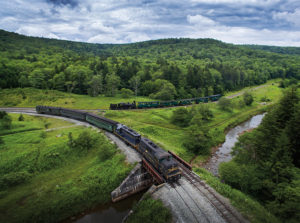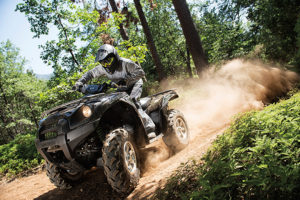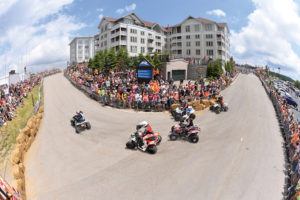According to the West Virginia Division of Tourism’s annual report, the Mountain State generated $14 in taxes for every $1 spent on advertising in Fiscal Year 2016. As the state continually searches for ways to increase revenue and diversify its struggling economy, organizations such as Durbin & Greenbrier Valley Railroad (DGVR), the Hatfield McCoy Trail System and Racer Productions are providing massive opportunities for statewide economic development and diversification.
These companies, which represent the commercial railroad, all-terrain vehicle (ATV) and motocross industries, draw thousands of visitors from outside of the state to West Virginia every year and have a significant economic impact on the surrounding Mountain State communities, bringing in revenue for local shops, accommodations and restaurants. Investing in these areas provides a significant opportunity not only for diversifying West Virginia’s economy but for diversifying the tourism industry itself.
Durbin & Greenbrier Valley Railroad

By Chase Gunnoe. Traveling eastbound on Route 33 near Buckhannon, WV, an SUV with a Pennsylvania registration is headed to Elkins with a family of four. Across several mountain ridges in Harrisonburg, VA, there’s a middle-age couple about to begin the scenic drive across Route 33 into Pendleton County and south from Seneca Rocks into Pocahontas County. These families, one from suburban Pittsburgh and the other from a Washington, D.C., bedroom community, have one thing in common: they are headed to the mountains of West Virginia to climb onboard a Durbin & Greenbrier Valley Railroad train.
Since the DGVR’s inception in 1997, hundreds of thousands of tourists have traveled to the highlands of West Virginia to ride the DGVR’s scenic Mountain Rail Adventures. Consistent growth over a span of two decades has led to expanded tourist train offerings and partnerships that have helped create an internationally recognized rail tourism destination.
The DGVR is a freight and tourist railroad serving the eastern mountain counties of West Virginia. Headquartered in Elkins, DGVR operates offices in Belington, Durbin and Cass in Barbour, Randolph and Pocahontas counties. With more than 120 miles of rail, 90,000 visitors and more than $4 million in annual revenues, the DGVR combines historic rail travel with West Virginia’s rugged scenery to form a destination that appeals to broad audiences.
Situated within a single day’s drive from Washington, D.C.; Pittsburgh, PA; Columbus, Ohio; and anywhere throughout West Virginia, the railroad brings in a wide range of tourists looking to experience railroads, scenery and an array of special events that tie into railroad and local culture.
One example is the Elkins-based Polar Express holiday train. Beginning in early November and lasting into mid-December, the Polar Express brings more than 15,000 visitors into Elkins to experience reenactments from the children’s movie made famous by author Chris Van Allsburg. Families from a 250-mile radius of Elkins travel to West Virginia to experience Christmas cheer on a cozy passenger train.
Onboard actors and a visit from Santa personalize the experience for families, but more importantly, they create memories that keep them coming back each holiday season. The Polar Express results in overnight lodging in the Elkins and I-79 region, as well as family package options with area restaurants and shops. The holiday trains contribute to an annual economic impact of more than $29.5 million, according to a study conducted by DGVR in 2010.
In 2015, railroad operations expanded again when DGVR began operating the Cass Scenic Railroad. Since then, DGVR has transformed day trips to Cass into overnight accommodations where visitors can board a train in Cass or Elkins and spend the night in the opposite destination. As opposed to a single-day trip, this creates more revenue for the region in that the overnight package options provide lodging, theatre and other on-site activities. Instead of the trains being the destination, they serve as the transportation to the destination.
The rail tourism industry is constantly changing because the staff at DGVR is always looking for new ways to diversify and build customer value. They are currently rebuilding a rail line that will connect Cass and Durbin, and that new corridor, about 11 miles in length, will offer outdoor recreation opportunities and more overnight options. With customer choices and different activities at each location, the railroad creates a valuable destination that keeps visitors returning year after year.
Whether it’s a holiday-themed train in Elkins, an overnight camping trip on a caboose or a visit with the world’s largest collection of geared Shay steam locomotives, DGVR appeals to a wide range of audiences that appreciate local culture and West Virginia.
Hatfield McCoy Trail System

By Jeffrey Lusk. When the Hatfield McCoy Trail System opened on Columbus Day in 2000, very few people realized how the trails would change the economy and future of Southern West Virginia. Today, in celebration of the trail system’s success, Columbus Day weekend is celebrated in the town of Gilbert in Mingo County with its annual Hatfield-McCoy National Trail Fest. The event plays host to more than 2,000 ATV riders who converge on the town for a near weeklong event of trail riding, outdoor music and a lot of mudslinging fun.
In 2000, the trail system opened with just over 300 miles of trails in two counties. On that opening day, Governor Cecil Underwood rode an ATV through the yellow ribbon at the beginning of the trails, followed by a dozen other riders. Was it possible that all the years of planning and hard work would pay off with a new tourism economy for Southern West Virginia? That small processional, led by the governor, was a signal to the world that Southern West Virginia was open for visitors—specifically, the kind who ride ATVs—but would they actually come? Almost 17 years later, the answer is a resounding yes. In fact, on most weekends, more of them want to come than there are beds, cabins, campsites and hotel rooms for.
The challenges the trail system faces today are far different than the initial challenges faced by this fledgling tourism destination. The first challenge was that the trail system had opened in very rural areas. The towns of Man and Matewan and the cities of Logan and Williamson were anchors for the new trails, and these locations had almost no lodging, very few restaurants and, outside of trail riding, no other developed tourism activities.
Despite these challenges, the growth of the trails exceeded everyone’s expectations. The caravans of trucks and SUVs towing trailers full of ATVs were enough to quiet even the greatest skeptic. The first full year of operations saw almost 4,000 riders visit the trail system, and in 2016, that number grew to 39,352.
The trail system now reaches out over five Southern West Virginia counties with more than 600 miles of trails, connecting 11 incorporated cities and towns. The latest economic impact study shows more than $22 million is being generated by the trails in the local economy, and it is supporting over 200 new jobs. The past 16 years have seen the opening of more than 40 new lodging businesses and campgrounds around the trails. These businesses, along with ancillary businesses such as restaurants, ATV rental companies, kayak rental companies and moonshine distilleries, now dot the landscape surrounding the trails and have created a true tourist destination for trail riders.
The future looks bright for tourism development on the trails, with six more projects in design or under construction that will open new trails in Boone, McDowell, Lincoln, Kanawha, Wayne and Wyoming counties. These projects, when complete, will connect the towns of Chesapeake, Danville, Gary, Madison, Oceana, War and Welch to the trails.
The success of the trails has not gone unnoticed at the national level. In 2016, the Appalachian Regional Commission (ARC) granted funding to help businesses develop along the trails. This grant, coupled with an ARC grant to the Natural Capital Investment Fund, will provide business coaching, small business training and risk capital to entrepreneurs developing businesses to support the trail system. The growth of the trail system and the entrepreneurial opportunities it provides are enormous. It continues to exceed all expectations and is serving as an engine for tourism growth and entrepreneurship.
Racer Productions

Photo by Ken Hill.
By Parween Mascari. Since the first Blackwater 100 in Tucker County, WV, in the 1970s, professional motorsports have proven to be a multi-million-dollar industry in West Virginia. Today, Racer Productions, headquartered in Morgantown, leads the charge in professional motorsports, driving the growth and success of the industry in the state.
The Coombs family, the leaders behind Racer Productions, has a long history in professional motorsports. Former pro rider Davey Coombs is the son of Rita Coombs, known as the matriarch of motocross, and Big Dave Coombs, who founded the National Promoters Group in the 1970s, as well as The Racing Paper 20 years ago and its spinoff, RacerX magazine. Davey’s sister, Carrie, is the country’s most influential woman in motorcycle racing. In addition to the magazine, Racer TV and a huge social media presence, the family owns and promotes multiple professional races and two professional racing series—The AMSOIL Grand National Cross Country (GNCC) Series and Lucas Oil Pro Motocross—through their promotion company, MX Sports. With races taking place coast to coast, Racer Productions has a nationwide following of more than 2 million Facebook followers and 1.5 million followers on Instagram.
According to Davey, the choice to keep their national headquarters in Morgantown is an easy one.
“Growing up, I was lucky enough to get to travel, and I knew from an early age how Morgantown stacked up to the rest of the country,” he says. “The overall sense of community is something you don’t see in a lot of other small cities this size, and the diversity the university brings makes us stand out even more.”
The economic benefit of having companies like Racer Productions and MX Sports headquartered in West Virginia doesn’t end on the track. The Morgantown Marriott sells out during the two GNCC banquets held there each December, and both awards banquets draw hundreds of riders and their families from across the country.
Professional race weekends bring thousands of spectators and millions of dollars into West Virginia. High Point Raceway hosted its first AMA motocross national four decades ago in 1977, and the 2017 race took place over Father’s Day weekend. Drawing a crowd of more than 10,000 spectators and a full weekend of family-friendly events, the annual Lucas Oil Pro Motocross Championship at High Point consists of mini-bike races, concerts and pro and amateur racing events. Located just 5 miles outside of Morgantown, the Greater Morgantown Convention and Visitors Bureau estimates that the indirect economic impact on Morgantown during that weekend is in excess of $1.3 million per year.
Racer Productions’ other professional racing series, GNCC, all started with the Blackwater 100 in Davis, WV, and now includes more than a dozen races each year in eight different states. GNCC has been America’s premier off-road racing series since 1975, and GNCC races that provide a direct economic benefit to West Virginia include the Marvin’s Mountaintop GNCC in Preston County, the Powerline Park GNCC outside Wheeling in St. Clairsville, Ohio, and the GNCC at Snowshoe Mountain Resort.
The 11th Snowshoe GNCC was held June 24-25 of this year. With a thousand competitors and thousands of spectators, it is easily Snowshoe Mountain Resort’s largest summer event. Billed as America’s toughest race with ATV races on Saturday and motorcycle racing on Sunday, this event draws thousands of visitors from all across the country to Pocahontas County, WV.
“Over the years, the GNCC event has grown in size to rival a great ski weekend,” says Frank DeBerry, Snowshoe’s president and COO. “Between overnight lodging, food, gas and travel, the total economic impact of this event on the resort and the community around Snowshoe is in the millions and, more importantly, helps support hundreds of jobs during a normally slow period.”








